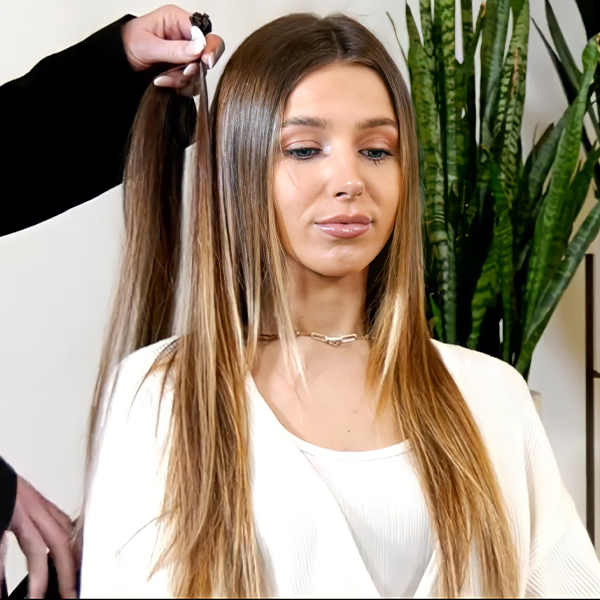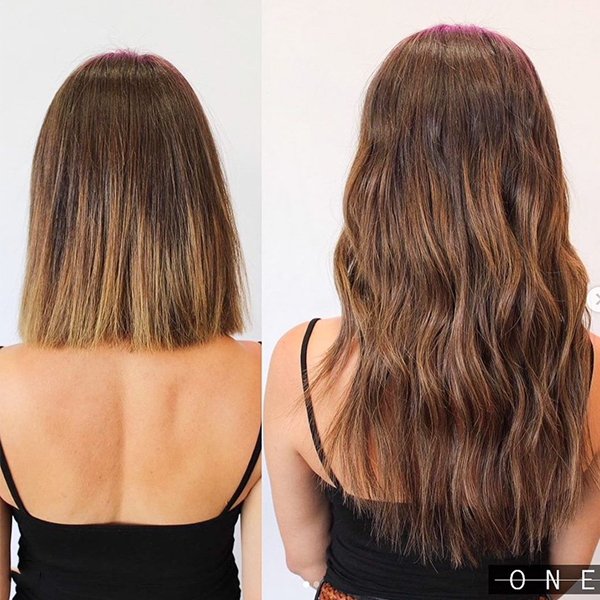3 Common Mistakes When Color Matching Extensions
Three Things To Avoid When Color Matching Extensions
Whether you have years of experience or you’re just stepping into the hair extension game, a bad color match can make or break your clientele. Learn what celebrity extension specialist Drea Jaclyn (@andreahenty) from Line One Hair says are the biggest mistakes she sees when color matching extensions.
1. Choosing Hair Extensions Shades That Are Too Light
Spoiler alert—applying light-colored extensions will not make your client’s hair look lighter. Drea explains that clients (blondes especially) will request lighter extensions thinking it will lighten the overall appearance of their hair. While this can be true for specific scenarios, using extensions that are lighter than your client’s natural hair color will actually create contrast and do the opposite. “Color match extensions to the client’s natural color, not what they want their color to be,” says Drea.
Pro Tip: While color matching, pull just a few pieces out of the bundle of extensions to see what the color will truly look like. When the extensions are grouped in a large bundle, colors can be misleading. Lay just a couple of pieces against your client’s head to see how the extensions will actually look when distributed.

2. Only Applying One Shade Of Extensions
The goal when color-matching extensions is to mimic your client’s natural hair. Almost no one’s hair is the same tone from root to end on every strand—extensions should be the same. Choosing a couple of colors, one perfectly matched and one slightly lighter (or darker) to the client’s hair can create a dimensional, natural look.
If your client is asking for a lighter or brighter color—applying more than one shade is the way to do it. Using a shade that matches your client’s natural color along with lighter tones will be able to disguise any lines of demarcation for enhanced color.
Check out this color correction from Drea—a great example of why you shouldn’t be using one shade of extensions to achieve a lighter color!


3. Matching Extensions To The Root Color
Struggling to determine where to begin color matching, especially on a client with a rooty blend?
Here’s Drea’s trick:
- If your client has a visibly darker root color than their ends, choose extensions that have a gradient similar to their existing color.
- If your client is primarily the same color from root to end, use their ends to color match before looking at the root.
This will help the extensions to blend seamlessly through the ends, aka—where you’ll be seeing them the most! Color matching based on client’s root color can leave you with extensions that look heavy and obvious through the ends.
Feel better about color matching? NOW make sure you choose the right type of extension for every client!

More from
Line One
-
Monthly Product Launch List
New Year, New Hair Launches—See The Best Ones So Far!
-
News
The Hottest Hair Product Launches Of Summer 2023
-
BTC Hair Trend Report
Subtle Ombré is The New Balayage—5 Tips You Must Know!
-
Product Launches
The Last Product Launch Before Summer 2023
-
BTC Hair Trend Report
2023 Hairstyling: 11 Trends You Need To Know
-
BTC Hair Trend Report
2023’s Biggest Haircut Trends
-
This Year’s BIGGEST Products: 2022’s Most Talked About
-
Blonde
The Biggest Hair Color Trends Of Winter 2023
-
Bobs
The Biggest Winter Haircut Trends To Kick Off 2023
-
Blonde
Celebrity On-Camera Blonde
-
Accessories
15 Styling Trends That Will Be Everywhere in Winter 2023
-
Fine/ Thinning
Fine Hair: Do You Know How To Handle It?
-
Monthly Product Launch List
7 New Hair Products For Pro Stylists To Try This Season
-
Styling
The HOTTEST Styling Trends Of Fall 2022
-
Product Launches
Our Editors Picked THESE Must-Try Fall Hair Products
-
#ONESHOT HAIR AWARDS
The BTC Show 2022: 10 Things We Saw
-
#ONESHOT HAIR AWARDS
Breaking News: 2022 #ONESHOT Hair Awards Winners
-
Extension Application
Extensions Where? Here’s A Must-Try Tip For Invisible Roots
-
Barbering
5 Genius Blonding, Color + Cutting Cheats To Try Now
-
Celebrity
Is Red Hair Spring 2022’s Hottest Trend?
-
Extension Application
How To Begin Offering Extension Services
-
Accessories
2022 Styling Trends To Know: Blowouts, Money Piece Braids + Hair Rollers
-
Balayage
15 Hair Color Trends You Need To Know In 2022
-
Haircuts
These Haircut Trends Will Be Everywhere In 2022





